Endocytic recycling in yeast is regulated by putative phospholipid translocases and the Ypt31p/32p-Rcy1p pathway
- PMID: 17093059
- PMCID: PMC1751321
- DOI: 10.1091/mbc.e06-05-0461
Endocytic recycling in yeast is regulated by putative phospholipid translocases and the Ypt31p/32p-Rcy1p pathway
Abstract
Phospholipid translocases (PLTs) have been implicated in the generation of phospholipid asymmetry in membrane bilayers. In budding yeast, putative PLTs are encoded by the DRS2 gene family of type 4 P-type ATPases. The homologous proteins Cdc50p, Lem3p, and Crf1p are potential noncatalytic subunits of Drs2p, Dnf1p and Dnf2p, and Dnf3p, respectively; these putative heteromeric PLTs share an essential function for cell growth. We constructed temperature-sensitive mutants of CDC50 in the lem3Delta crf1Delta background (cdc50-ts mutants). Screening for multicopy suppressors of cdc50-ts identified YPT31/32, two genes that encode Rab family small GTPases that are involved in both the exocytic and endocytic recycling pathways. The cdc50-ts mutants did not exhibit major defects in the exocytic pathways, but they did exhibit those in endocytic recycling; large membranous structures containing the vesicle-soluble N-ethylmaleimide-sensitive factor attachment protein receptor Snc1p intracellularly accumulated in these mutants. Genetic results suggested that the YPT31/32 effector RCY1 and CDC50 function in the same signaling pathway, and simultaneous overexpression of CDC50, DRS2, and GFP-SNC1 restored growth as well as the plasma membrane localization of GFP-Snc1p in the rcy1Delta mutant. In addition, Rcy1p coimmunoprecipitated with Cdc50p-Drs2p. We propose that the Ypt31p/32p-Rcy1p pathway regulates putative phospholipid translocases to promote formation of vesicles destined for the trans-Golgi network from early endosomes.
Figures

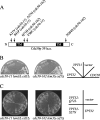
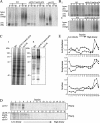

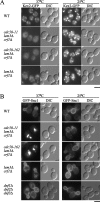
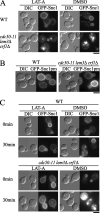
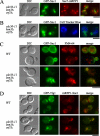
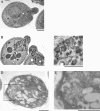
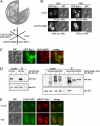
Similar articles
-
Interaction of the phospholipid flippase Drs2p with the F-box protein Rcy1p plays an important role in early endosome to trans-Golgi network vesicle transport in yeast.J Biochem. 2014 Jan;155(1):51-62. doi: 10.1093/jb/mvt094. Epub 2013 Nov 21. J Biochem. 2014. PMID: 24272750
-
Cdc50p, a protein required for polarized growth, associates with the Drs2p P-type ATPase implicated in phospholipid translocation in Saccharomyces cerevisiae.Mol Biol Cell. 2004 Jul;15(7):3418-32. doi: 10.1091/mbc.e03-11-0829. Epub 2004 Apr 16. Mol Biol Cell. 2004. PMID: 15090616 Free PMC article.
-
The functional relationship between the Cdc50p-Drs2p putative aminophospholipid translocase and the Arf GAP Gcs1p in vesicle formation in the retrieval pathway from yeast early endosomes to the TGN.Cell Struct Funct. 2006;31(2):87-108. doi: 10.1247/csf.06021. Epub 2006 Oct 23. Cell Struct Funct. 2006. PMID: 17062999
-
Linking phospholipid flippases to vesicle-mediated protein transport.Biochim Biophys Acta. 2009 Jul;1791(7):612-9. doi: 10.1016/j.bbalip.2009.03.004. Epub 2009 Mar 12. Biochim Biophys Acta. 2009. PMID: 19286470 Free PMC article. Review.
-
SNARE Protein Snc1 Is Essential for Vesicle Trafficking, Membrane Fusion and Protein Secretion in Fungi.Cells. 2023 Jun 5;12(11):1547. doi: 10.3390/cells12111547. Cells. 2023. PMID: 37296667 Free PMC article. Review.
Cited by
-
Mapping functional interactions in a heterodimeric phospholipid pump.J Biol Chem. 2012 Aug 31;287(36):30529-40. doi: 10.1074/jbc.M112.371088. Epub 2012 Jul 12. J Biol Chem. 2012. PMID: 22791719 Free PMC article.
-
Disruption of the lipid-transporting LdMT-LdRos3 complex in Leishmania donovani affects membrane lipid asymmetry but not host cell invasion.PLoS One. 2010 Aug 26;5(8):e12443. doi: 10.1371/journal.pone.0012443. PLoS One. 2010. PMID: 20865154 Free PMC article.
-
Up-regulation of Osh6 boosts an anti-aging membrane trafficking pathway toward vacuoles.Microb Cell. 2022 Jul 15;9(8):145-157. doi: 10.15698/mic2022.08.783. eCollection 2022 Aug 1. Microb Cell. 2022. PMID: 35974810 Free PMC article.
-
The putative flippase Apt1 is required for intracellular membrane architecture and biosynthesis of polysaccharide and lipids in Cryptococcus neoformans.Biochim Biophys Acta Mol Cell Res. 2018 Mar;1865(3):532-541. doi: 10.1016/j.bbamcr.2017.12.007. Epub 2017 Dec 29. Biochim Biophys Acta Mol Cell Res. 2018. PMID: 29291962 Free PMC article.
-
Phospholipid flippases in membrane remodeling and transport carrier biogenesis.Curr Opin Cell Biol. 2019 Aug;59:8-15. doi: 10.1016/j.ceb.2019.02.004. Epub 2019 Mar 18. Curr Opin Cell Biol. 2019. PMID: 30897446 Free PMC article. Review.
References
-
- Bai C., Sen P., Hofmann K., Ma L., Goebl M., Harper J. W., Elledge S. J. SKP1 connects cell cycle regulators to the ubiquitin proteolysis machinery through a novel motif, the F-box. Cell. 1996;86:263–274. - PubMed
Publication types
MeSH terms
Substances
LinkOut - more resources
Full Text Sources
Molecular Biology Databases

